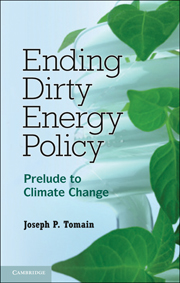Book contents
- Frontmatter
- Contents
- Preface
- Introduction
- 1 A Regulatory History of Dirty Energy Law and Policy
- 2 Protectionist Assumptions
- 3 The Next Generation Is Now
- 4 Consensus Energy Policy
- 5 Fossil Fuel Future
- 6 Electricity Future
- 7 Venture Regulation
- 8 Smart Energy Politics
- 9 Conclusion – Strategies for the Energy Future
- Notes
- Index
2 - Protectionist Assumptions
Published online by Cambridge University Press: 05 June 2012
- Frontmatter
- Contents
- Preface
- Introduction
- 1 A Regulatory History of Dirty Energy Law and Policy
- 2 Protectionist Assumptions
- 3 The Next Generation Is Now
- 4 Consensus Energy Policy
- 5 Fossil Fuel Future
- 6 Electricity Future
- 7 Venture Regulation
- 8 Smart Energy Politics
- 9 Conclusion – Strategies for the Energy Future
- Notes
- Index
Summary
I want to remind you about the fact that this economy of ours has been through a lot. And that's why it was important to get this energy bill done, to help us continue to grow…. This economy is strong, and it's growing stronger. And what this energy bill is going to do, it's just going to help keep momentum in the right direction so people can realize their dreams.
President Bush Signs Energy Policy Act of 2005The history of energy policy reveals the tight relationship between government and industry. Over the course of the last 100 years, government regulation supported an energy industry that developed certain structural characteristics. In turn, regulatory agencies adopted a similar organizational structure. Called the “hard path” by Amory Lovins more than thirty years ago, hard path energy industries were privately owned, corporate, large-scale, capital-intensive, centralized, and regionally, nationally, or internationally operated. The oil, natural gas, coal, nuclear power, and electricity industries each possess those characteristics. Additionally, federal and state regulators mirrored the corporate structure and are highly centralized, operate over large jurisdictional areas, and are departmentalized to mimic the corporate operations of their regulatees.
Energy industries are large-scale. Internationally, nearly 80 percent of the oil produced in the world is produced by fifty state-owned and private oil companies. In recent years, privately owned oil companies have experienced significant mergers, such that five of the remaining super majors are all ranked in the top eleven private corporations in the world.
- Type
- Chapter
- Information
- Ending Dirty Energy PolicyPrelude to Climate Change, pp. 43 - 64Publisher: Cambridge University PressPrint publication year: 2011



